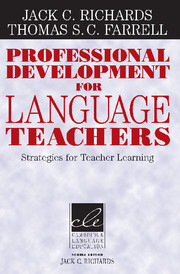Book contents
- Frontmatter
- Contents
- Series editor's preface
- Preface
- 1 The nature of teacher education
- 2 Workshops
- 3 Self-monitoring
- 4 Teacher support groups
- 5 Keeping a teaching journal
- 6 Peer observation
- 7 Teaching portfolios
- 8 Analyzing critical incidents
- 9 Case analysis
- 10 Peer coaching
- 11 Team teaching
- 12 Action research
- Appendix
- Index
9 - Case analysis
Published online by Cambridge University Press: 01 February 2010
- Frontmatter
- Contents
- Series editor's preface
- Preface
- 1 The nature of teacher education
- 2 Workshops
- 3 Self-monitoring
- 4 Teacher support groups
- 5 Keeping a teaching journal
- 6 Peer observation
- 7 Teaching portfolios
- 8 Analyzing critical incidents
- 9 Case analysis
- 10 Peer coaching
- 11 Team teaching
- 12 Action research
- Appendix
- Index
Summary
The nature of case analysis
Case analysis in teacher education involves collecting information over time about a teaching situation and using that information to help better understand the situation and to derive principles from it. In language teaching and other fields, it is based on the use of accounts (case studies) of how practitioners carry out their practice and resolve the issues that they confront. Case analysis has a long history in fields such as business, law, and medicine. In business education, for example, students might study a real-world example of a successful business venture and try to determine the principles that accounted for its success. The Harvard Law School has used case studies since 1870 (Carter & Unklesbay, 1989), but the case method of teaching did not enter into the field of education until much later. In fact, it was not until the mid-1980s that any literature was published on cases (Shulman, 1992), although vignettes, critical incidents, and classroom simulations have been used for some time to help novice teachers cope with their first years in the classroom (Kagan, 1993). In 1986, the Carnegie Task Force on Teaching as a Profession suggested that case methodology should be more widely used in teacher education courses: “Teaching ‘cases’ illustrating a great variety of teaching problems should be developed as a major focus of instruction” (1986, p. 76). In language teaching, a number of collections of cases have been published in recent years (e.g., Richards, 1998, and the TESOL Case Study series).
In order to understand what a case is, consider the issue of classroom management and how we could learn more about the principles of good classroom management.
- Type
- Chapter
- Information
- Professional Development for Language TeachersStrategies for Teacher Learning, pp. 126 - 142Publisher: Cambridge University PressPrint publication year: 2005

